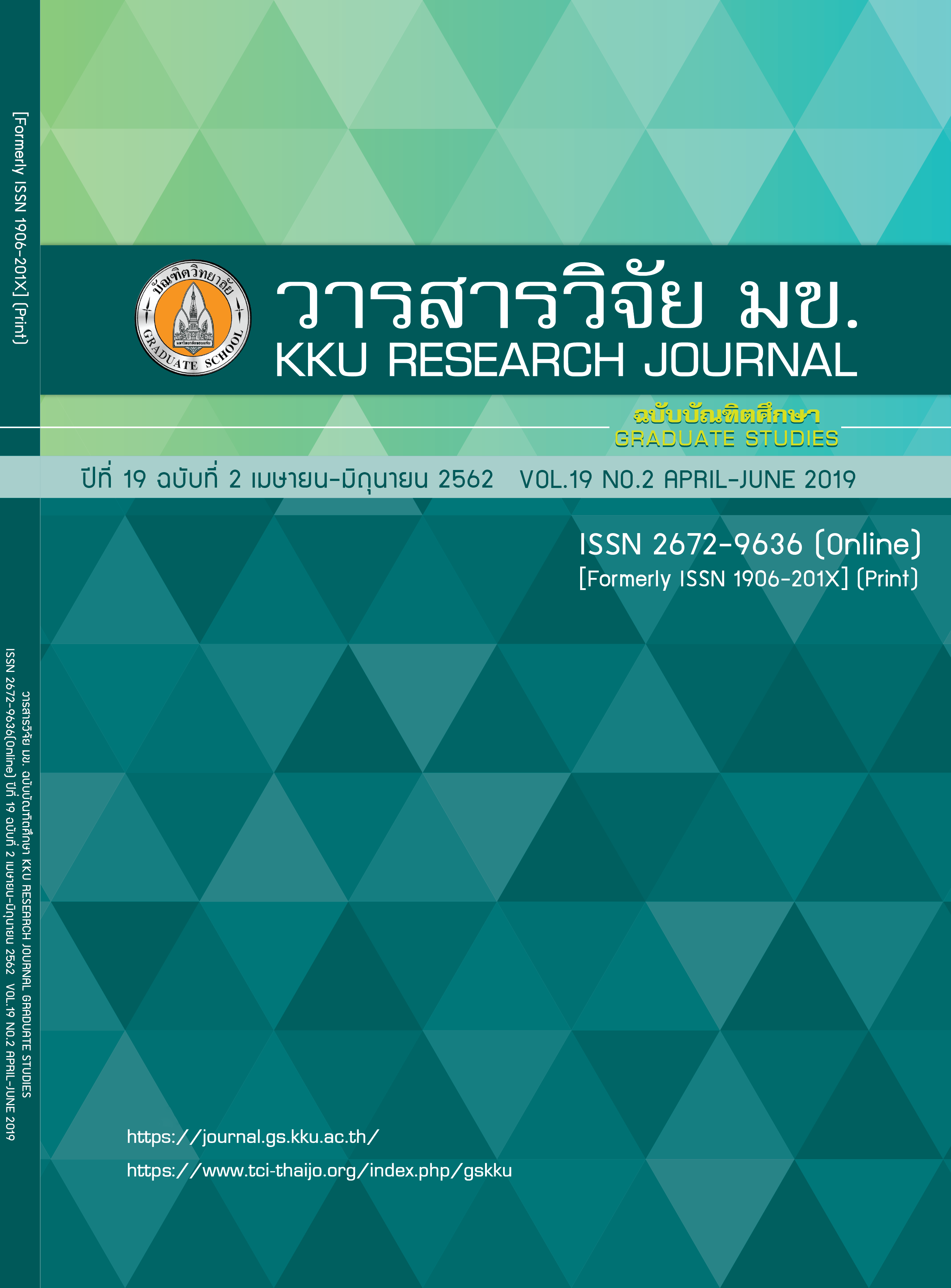Activated Carbon from Solid Waste of Pulp and Paper Industry and the Study of Color Removal of Wastewater
Keywords:
Activated carbon, Pulp residue, Pulp and paper industry, WastewaterAbstract
This research aimed to study the preparation of activated carbon from pulp residue, solid wastes from pulp and paper industry, by chemical activation with phosphoric acid (H3PO4) and physical activation with carbon dioxide (CO2). For H3PO4 activation, the calculated BET surface area of chemical activated carbon is 408–728 m2/g at the weight ratio of raw material to chemical 1:2–1:4, activation time 1 hr and carbonization temperatures of 400–600oC for 1 hr, while that of physical activated carbon drastically reduced to 14–57 m2/g at carbonization temperature of 400oC for 1 hr and activation temperature ranging from 600–800oC for 0.5–3 hrs. By investigating the equilibrium color adsorption capacity from bio-treated wastewater of pulp and paper industry by loading chemical and commercial activated carbon, as expected, it is found that the performance of color removal becomes higher as increasing the adsorbent loading. A 1.5 g of chemical activated carbon provided the highest color removal about 97%. In order to meet the industry-specific requirement for color removal of 58%, we found that our prepared activated carbon spent less time consuming (40 minutes) to remove color than the commercial one about 3 times, approximately. For further investigations of ADMI color and pH of wastewater after treatment with our chemical activated carbon, those measured values are acceptable. Therefore, we recommend that the activated carbon prepared by chemical activation be appropriate to be applied in the pulp and paper industry because of high adsorption rate and capacity, and recycling waste into useful products.
References
2. Mungkarndee P, Bantao C, Srisutikamol C. Treatment of Pulp and Paper Mill Wastewater Colour of The 1st National Conference 2015 on Innovative Education for Sustainable Development; 2008 July 15−16; Khon Kaen; Thailand.
3. Apiwatanapawat W, Kreetachat T, Vaithanomsat P. Decolorization of effluent from pulp and paper mill by ozone oxidation. Proceedings of 45th Kasetsart University Annual Conference: Architecture and Engineering and Natural Resources and Environment; 2007 January 30−February 2; Bangkok; Thailand.
4. Do D D. Adsorption analysis: Equilibria and kinetics. Singapore: Imperial College Press; 1998.
5. Ngernyen Y, Kamwilaisak K, Chano S, Eamdamrong P. Color removal of wastewater from pulp and paper industry by activated carbon. Engineering Journal Siam University. 2014; 15(2), 37−46. Thai.
6. Heidari A, Younesi H, Rashidi A, Ghoreyshi A. Adsorptive removal of CO2 on highly microporous activated carbons prepared from Eucalyptus camaldulensis wood: Effect of chemical activation. Journal of the Taiwan Institute of Chemical Engineers 2014; 45: 579˗588.
7. Yorgun S, Yildiz D. Preparation and characterization of activated carbons from Paulownia wood by chemical activation with H3PO4. Journal of the Taiwan Institute of Chemical Engineers 2015; 53: 122˗131.
8. Teng H, Yeh TS, Hsu LY. Preparation of activated carbon from bituminous coal with phosphoric acid activation. Carbon 1998; 36(9): 1387–1395.
9. Guo Y, Rockstraw DA. Physicochemical properties of carbons prepared from pecan shell by phosphoric acid activation. Bioresource Technology 2007; 98(8): 1513–1521.
10. Yun CH, Park YH, Park CR. Effects of pre-carbonization on porosity development of activated carbons from rice straw. Carbon 2001; 39(4): 559–567.
11. Azmi NB, Bashir MJK, Sethupathi S, Wei LJ, Aun NC. Stabilized landfill leachate treatment by sugarcane bagasse derived activated carbon for removal of color, COD and NH3-N – Optimization of preparation conditions by RSM. Journal of Environmental Chemical Engineering 2015, 3(2): 1287–1294.
12. Treviño-Cordero H, Juárez-Aguilar LG, Mendoza-Castillo DI, Hernández-Montoya V, Bonilla-Petriciolet A, Montes-Morán MA. Synthesis and adsorption properties of activated carbons from biomass of Prunus domestica and Jacaranda mimosifolia for the removal of heavy metals and dyes from water. Industrial Crops and Products 2013, 42(3): 315–323.
13. Shamsuddin MS, Yusoff NRN, Sulaiman MA. Synthesis and Characterization of Activated Carbon Produced from Kenaf Core Fiber Using H3PO4 Activation. Procedia Chemistry 2016, 19(1): 558–565.
14. Da Silva Lacerda V, López-Sotelo JB, Correa-Guimarães A, Hernández-Navarro S, Sánchez-Báscones M, Navas-Gracia LM, Martín-Gil J. Rhodamine B removal with activated carbons obtained from lignocellulosic waste. Journal of Environmental Management 2015, 155(5): 67–76
15. Ncibi MC, Ranguin R, Pintor MJ, Jeanne-Rose V, Sillanpää M, Gaspard S. Preparation and characterization of chemically activated carbons derived from Mediterranean Posidonia oceanica (L.) fibres. Journal of Analytical and Applied Pyrolysis 2014, 109(9): 205–214.
16. Tehrani NF, Aznar JS, Kiros Y. Coffee extract residue for production of ethanol and activated carbons. Journal of Cleaner Production 2015, 91(3): 64–70.
17. Gerçel Ö, Özcan A, Özcan AS, Gerçel HF. Preparation of activated carbon from a renewable bio-plant of Euphorbia rigida by H2SO4 activation and its adsorption behavior in aqueous solutions. Applied Surface Science 2007; 253(11): 4843–4852.



